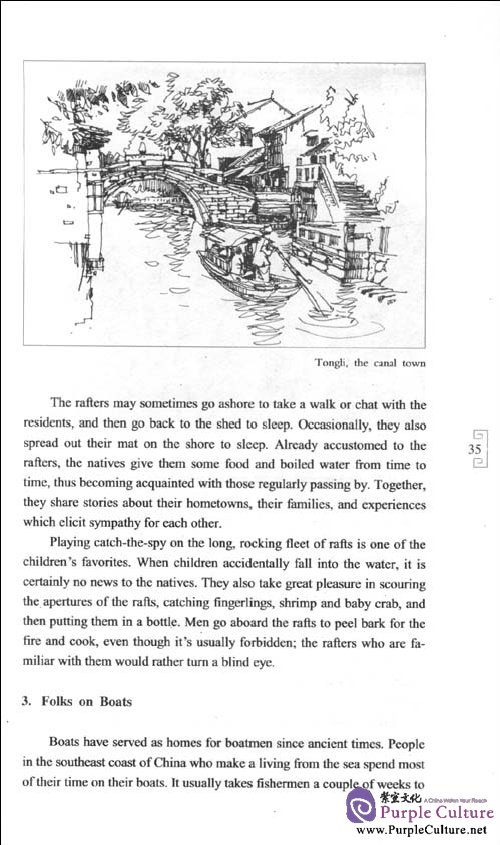Sample Pages Preview

The wood and bamboo transported to the Hangzhou-Jiaxing-Huzhou plain mainly come from the southern hills and the surrounding areas in Zhe- jiang Province. They are transported through the Qiantang River to the Shi- he River, or through the Grand Canal to other places. The long logs are re- quired to be made into rafts——eight or more logs aligned side by side and fixed to One another with peg woods or iron nails at both ends. The rafts are linked to one another with iron wire in the way carriages of a train are linked, so that each raft can make a turn freely. It is a spectacular sight to see dozens of rafts, linked to one another, snake their way down the river.
Navigating a parade of rafts is no easy task. The raftsmen on the first and the last raft are not only to pole but to steer also. Those on the other rafts, while poling, are to make sure that they follow the right direction. It is through joint effort that the parade of the rafts successfully makes its way. If, by accident, one of the rafts gets stuck on the dock wall or the aperture of a bridge, it causes great trouble, for the following rafts will get tangled up too, one after another, somewhat like the pile-ups on the free- way. In this case, the raftsmen have to pull each raft apart from the others and have all the rafts realigned before going on.
Preface
I grew up in one of the canal towns south of the Yangtze, an area crisscrossed by rivers and canals which added much plea- sure to the carefree childhood that still dwells, fresh and joyous, in my memory.
I have been through hard times: I was sent to the countryside far away from my hometown as an educated youth, recruited to a factory as a worker, and later, luckily, I was one of the first students admitted to college after the Cultural Revolution. After graduation, I have been to many places. Then, at the turn of the century, fate brought me to Shanghai and granted me opportunities to go back to my hometown. I hadn't been back for more than twenty years. Now, as a teacher and architect, I have many opportunities to frequent Hangzhou, Suzhou, Wuxi, Changshu, Shaoxing, Zhouzhuang, Zhujiajiao, Xitang, Wuzhen, Nanxun, and so on. The trips invariably bring me back to the days of long ago, and my ex- citement barely contained finds its vent in words, though the pen was put down and picked up many times.
Early this year, a friend of mine, Mr. LIU Jie, suggested that I wrote a book on the ups and downs of the traditional canal towns south of the Yangtze, which coincided with my own desire. I found in the process of writing that those towns, once prosperous and now survived, mostly developed along rivers, thus came the name of this book Canal Towns South of the Yangtze. Though it sounds ordinary, it is the most proper title. Articles with the same title are numerous, but this book, I believe, is distinctive from others in that it is written with words of reason out of the genuine emotion of an architect who grew up in one of those canal towns.
